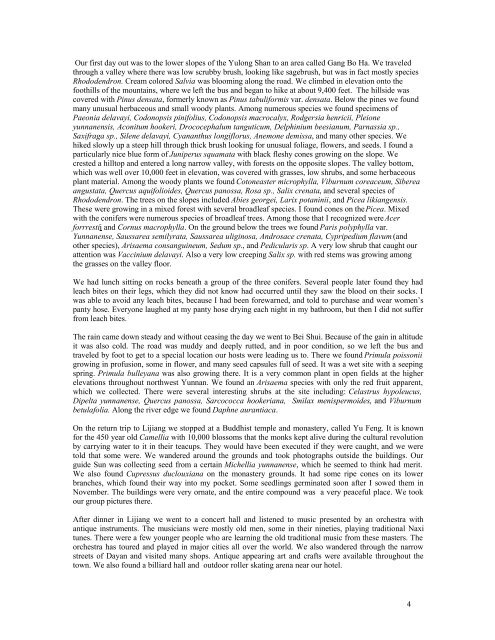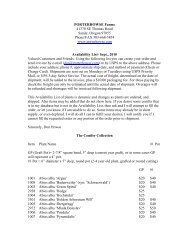CONIFERS IN YUNNAN.pdf - Porterhowse Farms
CONIFERS IN YUNNAN.pdf - Porterhowse Farms
CONIFERS IN YUNNAN.pdf - Porterhowse Farms
You also want an ePaper? Increase the reach of your titles
YUMPU automatically turns print PDFs into web optimized ePapers that Google loves.
Our first day out was to the lower slopes of the Yulong Shan to an area called Gang Bo Ha. We traveledthrough a valley where there was low scrubby brush, looking like sagebrush, but was in fact mostly speciesRhododendron. Cream colored Salvia was blooming along the road. We climbed in elevation onto thefoothills of the mountains, where we left the bus and began to hike at about 9,400 feet. The hillside wascovered with Pinus densata, formerly known as Pinus tabuliformis var. densata. Below the pines we foundmany unusual herbaceous and small woody plants. Among numerous species we found specimens ofPaeonia delavayi, Codonopsis pinifolius, Codonopsis macrocalyx, Rodgersia henricii, Pleioneyunnanensis, Aconitum hookeri, Drococephalum tanguticum, Delphinium beesianum, Parnassia sp.,Saxifraga sp., Silene delavayi, Cyananthus longiflorus, Anemone demissa, and many other species. Wehiked slowly up a steep hill through thick brush looking for unusual foliage, flowers, and seeds. I found aparticularly nice blue form of Juniperus squamata with black fleshy cones growing on the slope. Wecrested a hilltop and entered a long narrow valley, with forests on the opposite slopes. The valley bottom,which was well over 10,000 feet in elevation, was covered with grasses, low shrubs, and some herbaceousplant material. Among the woody plants we found Cotoneaster microphylla, Viburnum coreaceum, Sibereaangustata, Quercus aquifolioides, Quercus panossa, Rosa sp., Salix crenata, and several species ofRhododendron. The trees on the slopes included Abies georgei, Larix potaninii, and Picea likiangensis.These were growing in a mixed forest with several broadleaf species. I found cones on the Picea. Mixedwith the conifers were numerous species of broadleaf trees. Among those that I recognized were Acerforrrestii and Cornus macrophylla. On the ground below the trees we found Paris polyphylla var.Yunnanense, Saussarea semilyrata, Saussarea uliginosa, Androsace crenata, Cypripedium flavum (andother species), Arisaema consanguineum, Sedum sp., and Pedicularis sp. A very low shrub that caught ourattention was Vaccinium delavayi. Also a very low creeping Salix sp. with red stems was growing amongthe grasses on the valley floor.We had lunch sitting on rocks beneath a group of the three conifers. Several people later found they hadleach bites on their legs, which they did not know had occurred until they saw the blood on their socks. Iwas able to avoid any leach bites, because I had been forewarned, and told to purchase and wear women’spanty hose. Everyone laughed at my panty hose drying each night in my bathroom, but then I did not sufferfrom leach bites.The rain came down steady and without ceasing the day we went to Bei Shui. Because of the gain in altitudeit was also cold. The road was muddy and deeply rutted, and in poor condition, so we left the bus andtraveled by foot to get to a special location our hosts were leading us to. There we found Primula poissoniigrowing in profusion, some in flower, and many seed capsules full of seed. It was a wet site with a seepingspring. Primula bulleyana was also growing there. It is a very common plant in open fields at the higherelevations throughout northwest Yunnan. We found an Arisaema species with only the red fruit apparent,which we collected. There were several interesting shrubs at the site including: Celastrus hypoleucus,Dipelta yunnanense, Quercus panossa, Sarcococca hookeriana, Smilax menispermoides, and Viburnumbetulafolia. Along the river edge we found Daphne aurantiaca.On the return trip to Lijiang we stopped at a Buddhist temple and monastery, called Yu Feng. It is knownfor the 450 year old Camellia with 10,000 blossoms that the monks kept alive during the cultural revolutionby carrying water to it in their teacups. They would have been executed if they were caught, and we weretold that some were. We wandered around the grounds and took photographs outside the buildings. Ourguide Sun was collecting seed from a certain Michellia yunnanense, which he seemed to think had merit.We also found Cupressus duclouxiana on the monastery grounds. It had some ripe cones on its lowerbranches, which found their way into my pocket. Some seedlings germinated soon after I sowed them inNovember. The buildings were very ornate, and the entire compound was a very peaceful place. We tookour group pictures there.After dinner in Lijiang we went to a concert hall and listened to music presented by an orchestra withantique instruments. The musicians were mostly old men, some in their nineties, playing traditional Naxitunes. There were a few younger people who are learning the old traditional music from these masters. Theorchestra has toured and played in major cities all over the world. We also wandered through the narrowstreets of Dayan and visited many shops. Antique appearing art and crafts were available throughout thetown. We also found a billiard hall and outdoor roller skating arena near our hotel.4




